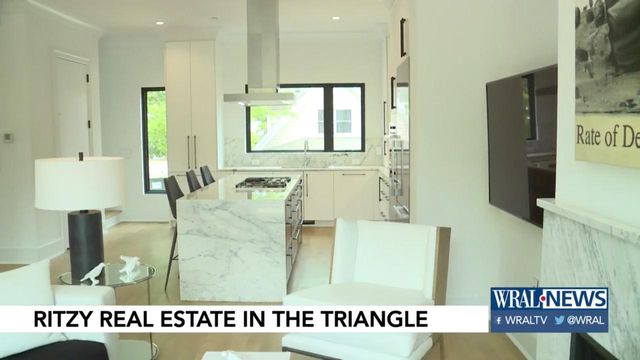Designer tips: Ideas for successfully staging your home
One way to make your home more impressionable for buyers is through the art of staging.
Posted — UpdatedIn a fast-paced house buying market, sellers often seek an advantage to help their homes stand out in the market.
It is essential for homeowners to strategically come up with ways to spark interest with home buyers and to close the deal ultimately. The ideal situation is for your home to appeal to a broad audience of buyers, which can help to gain top dollar with the sale of the house or investment.
Buyers typically make their decisions based on their first impression. With that in mind, any updates done to enhance the buyer’s impression can lead to closing the deal much faster.
One way to make your home more impressionable for buyers is through the art of staging. Staging is a solution that will help your home stand out amongst the competition.
The importance of staging
A staged home allows rooms to speak for themselves. In other words, the room’s clearly defined purpose is portrayed in its appearance and does not require a description or an introduction.
It helps to distract from areas that are plain and lack interest. Sellers may question whether or not staging is essential for the sale of their home, but studies have shown that staged homes sell much faster than empty ones.
A question often asked by home sellers is, “what makes my home any more special than similar homes on the market?”
This is a fair question as oftentimes; there is no difference. One way to make your home stand out is to address what buyers want to feel when they enter the home. You want the buyer to be able to visualize themselves in your home and have an idea of what living in the house will feel like to them. The answer to this question is the most critical consideration when it comes to staging. Staging does not have to be expensive. In most cases, you already have what you need. The key is knowing what areas and what items are most important to gain a buyer’s interests.
Here are some simple ways to successfully stage key areas of your home:
Master bedroom
Without staging, a bedroom would otherwise be simply four walls, a floor, and a ceiling. Bedrooms are pretty basic without having specific features that standout. These standouts would include such details as an architectural ceiling, placement of windows, trim molding, and the size of the room as well as the closet.
Unfortunately, not all bedrooms have these grand details and visual interests. In these cases, staging may be the best option to enhance the space and to help answer questions that buyers may have. For example, staging a bed in a specific area would help buyers determine if a king-sized bed will fit in the space, or if there is enough space for current furniture such as nightstands or seating.
When staging the bedroom, be sure to keep the room as spacious as possible. This means moving out any unnecessary furniture that does not have a purpose. The bed is the primary focal point, so position it accordingly.
The mattress and bedding should look inviting and also positioned to avoid obstacles with entry and exits. Bedding should be kept simple, tidy, and layered to create a feeling of plushness and comfort. This update guides the buyer’s attention away from the simplicity of a room with four walls.
Bathroom
The condition and appearance of a bathroom can be the key decision-maker for buyers. Bathrooms sometimes require a little TLC in order to gain interest with buyers. To make a good impression, adding a few touches to enhance the look and feel can help to spark interest. One way to stage your bathroom is to make it feel like a spa experience. Consider a graphic or textured upgrade to your shower curtain. Since the shower curtain covers a large viewing area, an update would provide an instant transformation. To continue with a spa look, consider adding fresh white towels, soaps, and candles to enhance the mood. Remove all personal items and keep the space clean and straightforward.
Living room
Arrange furniture in a way that focuses attention on compelling home features such as a fireplace, an entertainment unit, or in ways that take advantage of window views. Keep the colors neutral, light, and as bright as possible so that the room feels more substantial and more expansive.
Open blinds and drapes during the day and turn on ambient lighting during the evening hours. Use pattern and texture to help bring a feeling of luxury, comfort, and coziness. It is essential to clear clutter, pare down and move out your personalized belongings as much as possible.
Furniture helps to define the space. If you have existing furniture, it is crucial to minimize and neutralize as much as possible. With this change, the buyer can focus on the position and purpose rather than the style and appearance. One way to make substantial furniture less significant is to keep the color palette monochromatic. In other words, use sofa covers, pillows, throws, etc. in a similar color so that the items blend rather than stand out to avoid unnecessary attention. Remember the goal is to sell the house and not the furniture.
Home exterior
The exterior of your home gives the buyer an initial impression of what to expect inside. Sometimes this impression can make or break their decision to look inside. Remember not to neglect the exterior of your home when selling. Staging your home’s exterior does not have to be expensive. A few ways to successfully stage the home’s exterior without high cost includes cutting the grass and trimming the shrubs. This effort shows buyers that you take pride in the upkeep of your home. Be sure that the entryway to your home is clear, accessible, and feels as grand as possible. Add a door wreath and new welcome mat to show buyers that you are ready and willing to accept visitors and welcome offers.
Is staging always necessary?
Home staging is not always necessary. As previously stated, staging can help define a space, or it can even take focus away from areas that are plain and unresolved. For high-interest areas such as kitchens and bathrooms, it is important not to distract from details that should stand out.
For example, areas with detailed wood trim and accents, stone and wood, and special features and enhancements, should be celebrated in a way that makes your home stand out amongst the competition. Be sure not to block these details with unnecessary staging, but rather add elements that will draw attention to these features. For example, maximize tiled kitchen backsplashes and stone countertops by minimizing the number of items on counters and celebrate the investments with under cabinet lighting. Contrasting paint colors can also help to emphasize trim work such as crown molding and wainscoting.
In summary, staging can highlight your home's strengths and downplay its weaknesses, so it is important to be intentional about what works for a broader buying audience. While the buyer is not buying your furniture, you are still selling them an idea. The idea that your home can easily be their home. Remember that your main objective should be to impress the buyer by creating a space that is memorable and leaves an unforgettable impression!
Howard Eason, the owner of HE Designs, LLC, is a sought-after Residential and Commercial Designer. As a Design Strategist, he utilizes his skills to serve the Raleigh and Triangle area, Washington, DC Metro area, and the New York suburbs. Howard is an alumnus of North Carolina Central University and Mount Olive University. He received national recognition as a contestant on HGTV's All American Handyman. He is also known locally for his contributions as a Design Expert on former NBC and CBS talk shows.





